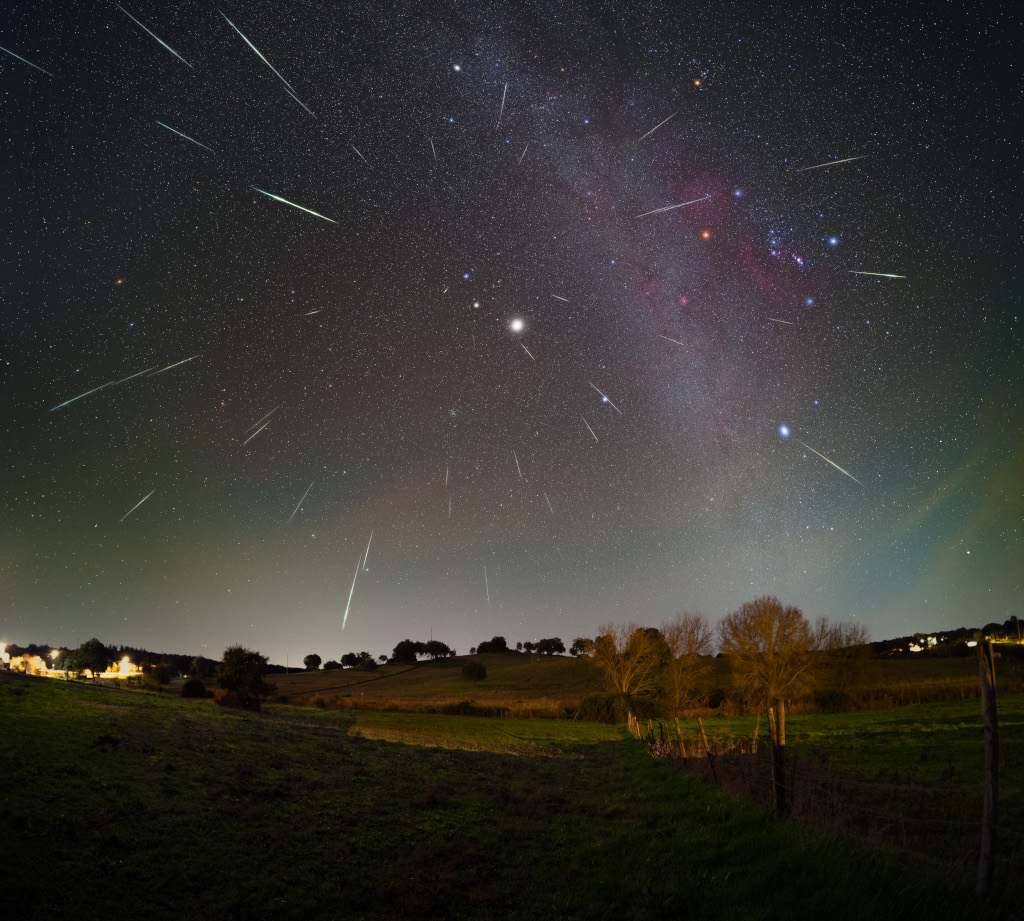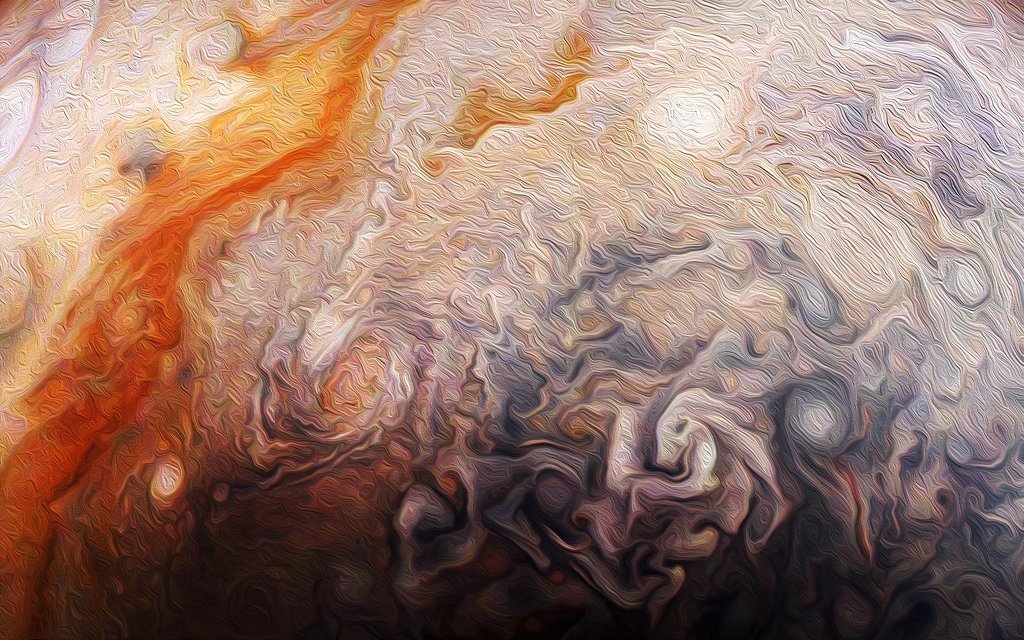Η Αστρονομική Εικόνα της Ημέρας από τη NASA
Jupiter and the Meteors from Gemini
18/12/2025
Jupiter, the Solar System's ruling gas giant, is the brightest celestial beacon at the center of this composite night skyscape. The scene was constructed by selecting the 40 exposures containing meteors from about 500 exposures made on the nights of December 13 and 14, near peak activity for this year's annual Geminid meteor shower. With each selected exposure registered in the night sky above Alentejo, Portugal, planet Earth, it does look like the meteors are streaming away from Jupiter. But the apparent radiant of the Geminid meteors is actually closer to bright star Castor, in the shower's eponymous constellation Gemini. In this frame that's just a little above and left of the Solar System's most massive planet. Still, the parent body of Geminid meteors is known to be rocky, near-Earth asteroid 3200 Phaethon. And the orbit of Phaethon itself is influenced by the gravitational attraction exerted by massive Jupiter, in concert with planets of the inner Solar System.
Copyright: David Cruz
Προηγούμενες Αστρονομικές Εικόνες της Ημέρας από τη NASA
Terminator Moon: A Moonscape of Shadows
22/04/2025
What's different about this Moon? It's the terminators. In the featured image, you can't directly see any terminator -- the line that divides the light of day from the dark of night. That's because the featured image is a digital composite of many near-terminator lunar strips over a full Moon. Terminator regions show the longest and most prominent shadows -- shadows which, by their contrast and length, allow a flat photograph to appear three-dimensional. The overlay images were taken over two weeks in early April. Many of the Moon's craters stand out because of the shadows they all cast to the right. The image shows in graphic detail that the darker regions known as maria are not just darker than the rest of the Moon -- they are also flatter. Dial-A-Moon: Find the Moon phase on your birthday this year
Copyright: Rich Addis
Galaxy Lenses Galaxy from Webb
21/04/2025
Is this one galaxy or two? Although it looks like one, the answer is two. One path to this happening is when a small galaxy collides with a larger galaxy and ends up in the center. But in the featured image, something more rare is going on. Here, the central light-colored elliptical galaxy is much closer than the blue and red-colored spiral galaxy that surrounds it. This can happen when near and far galaxies are exactly aligned, causing the gravity of the near galaxy to pull the light from the far galaxy around it in an effect called gravitational lensing. The featured galaxy double was taken by the Webb Space Telescope and shows a complete Einstein ring, with great detail visible for both galaxies. Galaxy lenses like this can reveal new information about the mass distribution of the foreground lens and the light distribution of the background source.
Copyright: NASA
The Orion Nebula in Visible and Infrared
20/04/2025
The Great Nebula in Orion is a colorful place. Visible to the unaided eye, it appears as a small fuzzy patch in the constellation of Orion. Long exposure, multi-wavelength images like this, however, show the Orion Nebula to be a busy neighborhood of young stars, hot gas, and dark dust. This digital composite features not only three colors of visible light but four colors of infrared light taken by NASA's orbiting Spitzer Space Telescope as well. The power behind much of the Orion Nebula (M42) is the Trapezium - four of the brightest stars in the nebula. Many of the filamentary structures visible are actually shock waves - fronts where fast moving material encounters slow moving gas. The Orion Nebula spans about 40 light years and is located about 1500 light years away in the same spiral arm of our Galaxy as the Sun.
Copyright: Infrared: NASA, Spitzer Space Telescope; Visible: Oliver Czernetz, Siding Spring Obs.
Painting with Jupiter
19/04/2025
In digital brush strokes, Jupiter's signature atmospheric bands and vortices were used to form this interplanetary post-impressionist work of art. The creative image from citizen scientist Rick Lundh uses data from the Juno spacecraft's JunoCam. To paint on the digital canvas, a JunoCam image with contrasting light and dark tones was chosen for processing and an oil-painting software filter applied. The image data was captured during perijove 10. That was Juno's December 16, 2017 close encounter with the solar system's ruling gas giant. At the time the spacecraft was cruising about 13,000 kilometers above northern Jovian cloud tops. Now in an extended mission, Juno has explored Jupiter and its moons since entering orbit around Jupiter in July of 2016.
Copyright: NASA
Comet C/2025 F2 SWAN
18/04/2025
In late March, the comet now designated C/2025 F2 SWAN was found independently by citizen scientists Vladimir Bezugly, Michael Mattiazzo, and Rob Matson while examining publicly available image data from the Solar Wind ANisotropies (SWAN) camera on the sun-staring SOHO spacecraft. Comet SWAN's coma, its greenish color a signature of diatomic carbon molecules fluorescing in sunlight, is at lower left in this telescopic image. SWAN's faint ion tail extends nearly two degrees toward the upper right across the field of view. The interplanetary scene was captured in clear but moonlit skies from June Lake, California on April 14. Seen against background of stars toward the constellation Andromeda, the comet was then some 10 light-minutes from our fair planet. Now a target for binoculars and small telescopes in northern hemisphere morning skies this comet SWAN is headed for a perihelion, its closest approach to the Sun, on May 1. That will bring this visitor from the distant Oort cloud almost as close to the Sun as the orbit of inner planet Mercury.
Copyright: Dan Bartlett
Virgo Cluster Galaxies
17/04/2025
Galaxies of the Virgo Cluster are scattered across this nearly 4 degree wide telescopic field of view. About 50 million light-years distant, the Virgo Cluster is the closest large galaxy cluster to our own local galaxy group. Prominent here are Virgo's bright elliptical galaxies from the Messier catalog, M87 at bottom left, and M86 and M84 near center right. M86 and M84 are recognized as part of Markarian's Chain, the visually striking line-up of galaxies on the that runs through the upper portion of this frame. Near the middle of the chain lies an intriguing interacting pair of galaxies, NGC 4438 and NGC 4435, known to some as Markarian's Eyes. Still, giant elliptical galaxy M87 dominates the Virgo cluster. It's the home of a super massive black hole, the first black hole ever imaged by planet Earth's Event Horizon Telescope.
Copyright: Daniel Adibi
Halo of the Cat's Eye
16/04/2025
What created the unusual halo around the Cat's Eye Nebula? No one is sure. What is sure is that the Cat's Eye Nebula (NGC 6543) is one of the best known planetary nebulae on the sky. Although haunting symmetries are seen in the bright central region, this image was taken to feature its intricately structured outer halo, which spans over three light-years across. Planetary nebulae have long been appreciated as a final phase in the life of a Sun-like star. Only recently however, have some planetaries been found to have expansive halos, likely formed from material shrugged off during earlier puzzling episodes in the star's evolution. While the planetary nebula phase is thought to last for around 10,000 years, astronomers estimate the age of the outer filamentary portions of the Cat's Eye Nebula's halo to be 50,000 to 90,000 years.
Copyright: Taavi Niittee (Tõrva Astronomy Club)
Planetary Nebula NGC 1514 from Webb
15/04/2025
What happens when a star runs out of nuclear fuel? For stars like our Sun, the center condenses into a white dwarf while the outer atmosphere is expelled into space to appear as a planetary nebula. The expelled outer atmosphere of planetary nebula NGC 1514 appears to be a jumble of bubbles -- when seen in visible light. But the view from the James Webb Space Telescope in infrared, as featured here, confirms a different story: in this light the nebula shows a distinct hourglass shape, which is interpreted as a cylinder seen along a diagonal. If you look closely at the center of the nebula, you can also see a bright central star that is part of a binary system. More observations might better reveal how this nebula is evolving and how the central stars are working together to produce the interesting cylinder and bubbles observed. Jump Around the Universe: Random APOD Generator
Copyright: NASA
Η Αστρονομική Εικόνα της Ημέρας από τη NASA (NASA Astronomy Picture of the Day) είναι μια δωρεάν υπηρεσία που παρέχει καθημερινά μια εντυπωσιακή εικόνα από το σύμπαν, την λήψη της οποίας έχει πραγματοποιήσει κάποιος από τους αστρονόμους της NASA ή από κάποιον από τους δορυφόρους ή τα τηλεσκόπια που η NASA λειτουργεί. Οι εικόνες που εμφανίζονται καλύπτουν μια ευρεία γκάμα από θέματα, συμπεριλαμβανομένων των αστερισμών, των γαλαξιών, των πλανητικών συστημάτων, των κομητών, των αστρικών σωμάτων και των παρατηρητηρίων. Κάθε εικόνα συνοδεύεται από μια σύντομη εξήγηση και πληροφορίες σχετικά με το τι παρατηρείται στην εικόνα.








